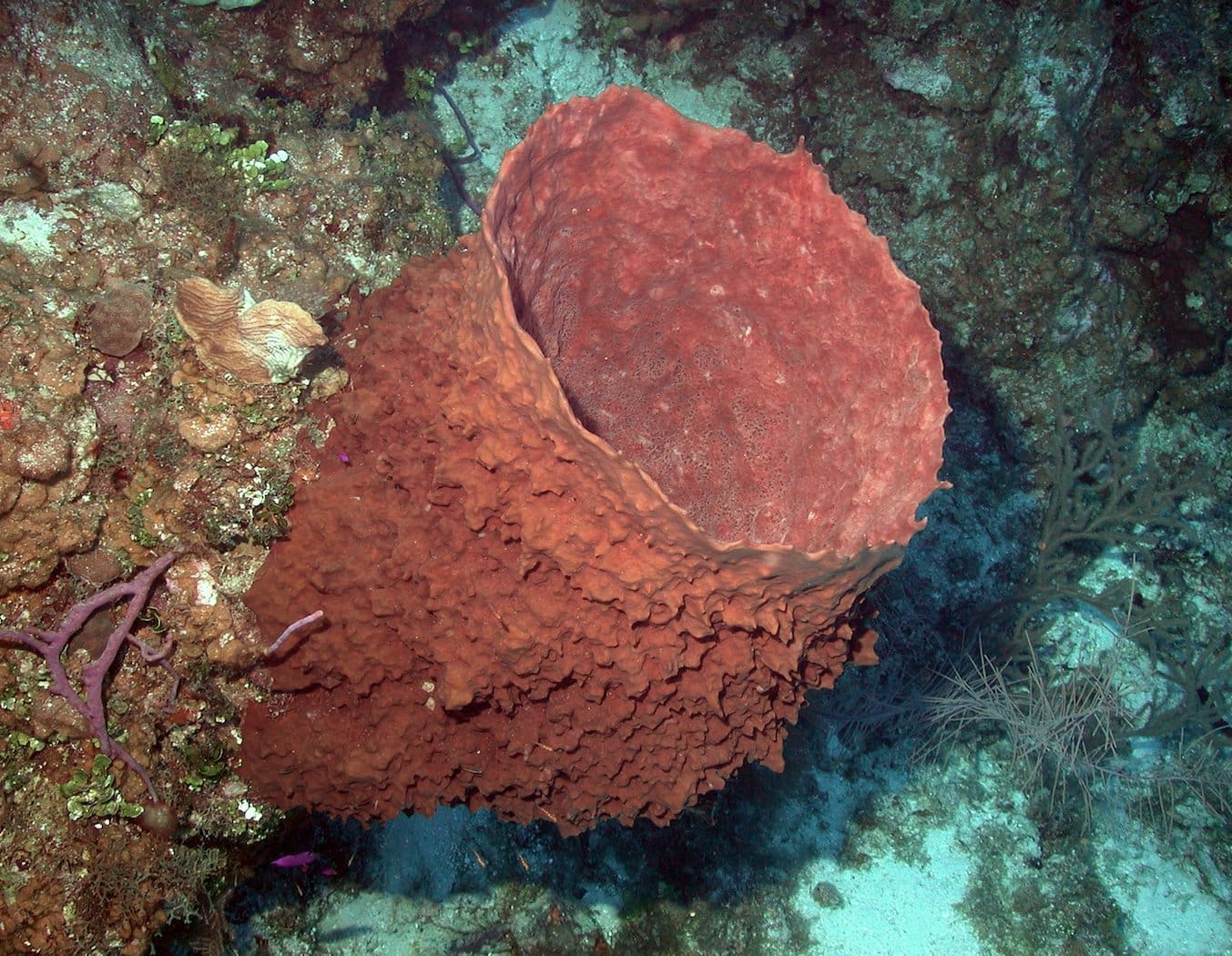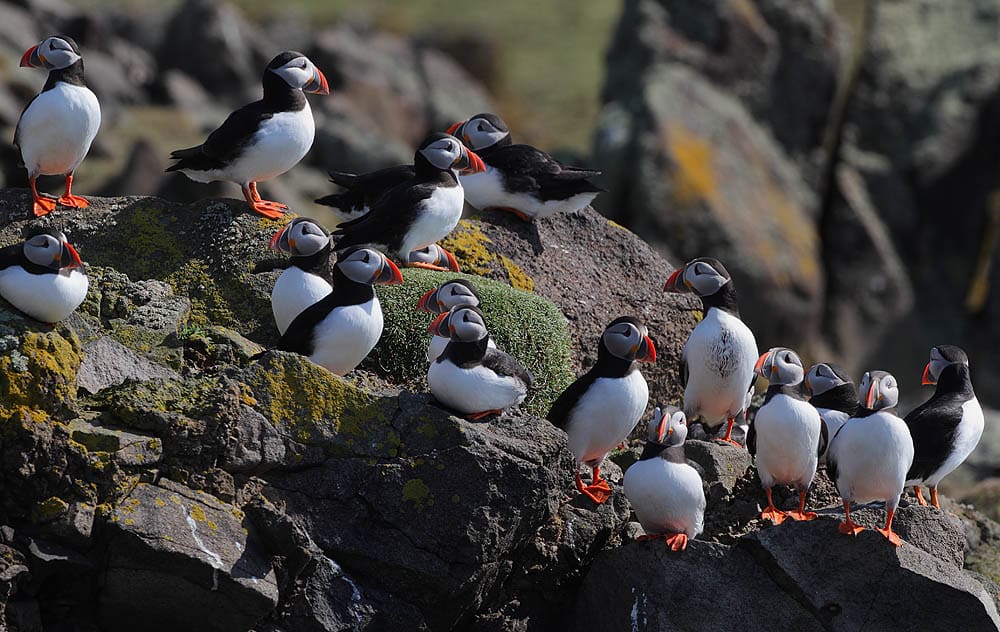What creature grows tall and sturdy, cleans up its neighborhood, and defends itself from predators – all without moving a muscle?
The Giant Barrel Sponge, or Xestospongia muta!

A Giant Barrel by any other name…
Giant barrel sponges are aptly named for their shape and great size. They grow over 1 m tall, but only grow an average of about 1.5 cm a year. After all, good things take time!
Giant barrel sponges come in a range of colors, depending on the presence of the cyanobacteria that they work with in symbiosis. They can be pink, purple, brown, reddish brown, and gray, and tend to be different colors at different depths.
You may be wondering why this “giant barrel” doesn’t look very much like Spongebob Squarepants, or the sponge you use to clean up in the kitchen. Well sponges, or animals of the phylum Porifera, come in all shapes and sizes, and there is great diversity among the 8,550 species of them. Sponges are quite ancient, with their oldest fossil records dating back 600 million years, so they’ve had time to differentiate and find their own ecological niches.
The giant barrel sponge is known as the “Redwood of the Sea.” The phrase comes from the fact that giant barrel sponges share the tendency for individuals to live long lives, from a few hundred to thousands of years old. In fact, the oldest known giant barrel sponge is over 2000 years old.
Old age isn’t the only thing they have in common with their counterparts on land. Like the magnificent redwoods, they do wonders to clean up and support the environment around them. Giant barrel sponges can filter up to 50,000 times their own volume in water in a single day. They also provide habitat to several small fish and other invertebrates that can be found living inside or on the surface of the sponge.

How does such a giant creature sustain itself?
Although giant barrel sponges are, well, giant, their diet is anything but. These creatures, like many species of whales, sustain their size not by eating very large sources of food, but by eating large volumes of it. Giant barrel sponges are filter feeders, and consume microorganisms from the water around them that they pump through their bodies. The sponges have special cells along their inner cavities called choanocytes, which work to facilitate the movement of water and the capture of food from it.
In their ocean food chain, giant barrel sponges take their place above their symbiotic partners cyanobacteria, and are consumed in turn by macroorganisms like fishes, turtles, and sea urchin. They try to defend themselves by releasing chemicals to repel their predators, but there’s only so much they can do when stuck in one place, waiting to be ingested by so many types of marine life. Like other filter feeders, giant barrel sponges ultimately form an important branch in the transfer of nutrients from very small to much larger life forms.
They don’t even have tissues, let alone organs, but their simple structure is more than enough to ensure their survival and proliferation. Giant barrel sponges reproduce by spawning, and are one of the few species of sponge that undertake sexual reproduction. Males and females release sperm and egg cells into the ocean synchronously, so that when the time comes, they have a chance of contributing to a fertilized egg that grows into a larva and, after being carried by currents to a new spot of the ocean floor, establishes itself as an independent sponge.
Check out this short video of the spawning phenomenon:
A valued community member
Giant barrel sponges are native to the oceans of the Americas, found primarily in the Caribbean Sea, and observed as far south as the coasts of Venezuela.
Due to their filtration capabilities, giant barrel sponges are real assets to the ecosystems they are a part of, but boosting water quality is not the only ecological role they play. As mentioned, many other creatures live in and around the cavernous sponges, and giant barrel sponges are one of the largest organisms in the coral reef environments where they are found. They are thought to help coral anchor to substrate (the mix of mineral, rock, and skeleton that binds reefs together), and themselves make up about 9% of coral reef substrate in certain areas where they are found. By helping in this binding process, giant barrel sponges can play an important role in reef regeneration.
Though the giant barrel sponge is not currently classified as threatened, like all of us, it is living in vulnerable times, as reef habitats are weakened in warming, acidifying waters. It is susceptible to a disease called Sponge Orange Band disease that afflicts all kinds of sponges. They can also be damaged or killed by human activities that disturb reefs and break sponges off from their surroundings.
On the flip side, when these great creatures are doing well, they enable the thriving of life all around them. May all of us aspire to say the same.
With one giant smile,
Maya

Maya Dutta is an environmental advocate and ecosystem restorer working to spread understanding on the key role of biodiversity in shaping the climate and the water, carbon, nutrient and energy cycles we rely on. She is passionate about climate change adaptation and mitigation and the ways that community-led ecosystem restoration can fight global climate change while improving the livelihood and equity of human communities. Having grown up in New York City and lived in cities all her life, Maya is interested in creating more natural infrastructure, biodiversity, and access to nature and ecological connection in urban areas.
Sources and Further Reading:
https://animaldiversity.org/accounts/Xestospongia_muta
https://oceana.org/marine-life/corals-and-other-invertebrates/giant-barrel-sponge
https://en.wikipedia.org/wiki/Giant_barrel_sponge
https://www.americanoceans.org/species/giant-barrel-sponge
https://oceanservice.noaa.gov/facts/sponge.html





